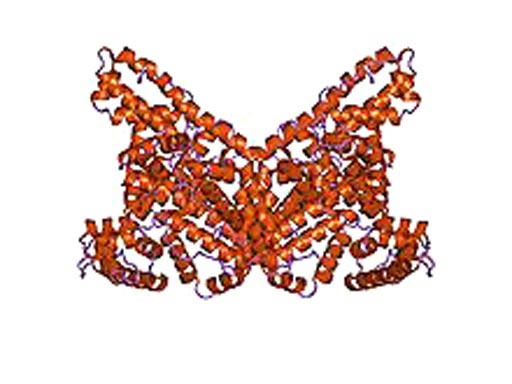Study Shows Varied Results from Different Methods of Measuring Albumin
|
By LabMedica International staff writers Posted on 21 Feb 2017 |

Image: A structural model of serum albumin (Photo courtesy of Wikimedia Commons).
A recent paper compared the accuracy of several different methods for determining levels of serum or plasma albumin, measurements, which are used to evaluate the nutritional status, kidney function, and fluid balance of dialysis patients.
Investigators at the University of Virginia Health System and Virginia Commonwealth University used 24 testing methods offered by various companies to analyze pools that had been prepared from residual patient serum and heparin plasma from patients without renal disease, and serum from patients with kidney failure before hemodialysis. Albumin was measured in all samples and in ERM-DA470k/IFCC reference material (RM) by three immunochemical, nine bromcresol green (BCG), and 12 bromcresol purple (BCP) methods.
Results revealed that two of three immunochemical procedures, five of nine BCG, and 10 of 12 BCP methods recovered the RM value within its uncertainty. One immunochemical and three BCG methods were biased versus the RM value. Random error components were small for all measurement procedures. Biases for plasma samples were generally higher than for serum samples for all method types. For most measurement procedures, biases were lower for serum from patients on hemodialysis versus patients without kidney disease.
“Nephrologists follow albumin results closely because the results are going to tell them if they need to do anything extra for these patients,” said contributing author Dr. David Bruns, professor of pathology at the University of Virginia Health System. “We know for a fact that this [albumin levels] correlates with mortality. National guidelines define what an acceptable range is and what is not acceptable.”
The investigators concluded that significant differences among immunochemical, BCG, and BCP methods compromised the interpretation of serum albumin results. Therefore, guidelines and calculations for clinical management of kidney and other diseases must consider the method used for albumin measurement until harmonization can be achieved.
The study was published in the January 2017 issue of the journal Clinical Chemistry.
Investigators at the University of Virginia Health System and Virginia Commonwealth University used 24 testing methods offered by various companies to analyze pools that had been prepared from residual patient serum and heparin plasma from patients without renal disease, and serum from patients with kidney failure before hemodialysis. Albumin was measured in all samples and in ERM-DA470k/IFCC reference material (RM) by three immunochemical, nine bromcresol green (BCG), and 12 bromcresol purple (BCP) methods.
Results revealed that two of three immunochemical procedures, five of nine BCG, and 10 of 12 BCP methods recovered the RM value within its uncertainty. One immunochemical and three BCG methods were biased versus the RM value. Random error components were small for all measurement procedures. Biases for plasma samples were generally higher than for serum samples for all method types. For most measurement procedures, biases were lower for serum from patients on hemodialysis versus patients without kidney disease.
“Nephrologists follow albumin results closely because the results are going to tell them if they need to do anything extra for these patients,” said contributing author Dr. David Bruns, professor of pathology at the University of Virginia Health System. “We know for a fact that this [albumin levels] correlates with mortality. National guidelines define what an acceptable range is and what is not acceptable.”
The investigators concluded that significant differences among immunochemical, BCG, and BCP methods compromised the interpretation of serum albumin results. Therefore, guidelines and calculations for clinical management of kidney and other diseases must consider the method used for albumin measurement until harmonization can be achieved.
The study was published in the January 2017 issue of the journal Clinical Chemistry.
Latest Clinical Chem. News
- POC Breath Diagnostic System to Detect Pneumonia-Causing Pathogens
- Online Tool Detects Drug Exposure Directly from Patient Samples
- Chemical Imaging Probe Could Track and Treat Prostate Cancer
- Mismatch Between Two Common Kidney Function Tests Indicates Serious Health Problems
- VOCs Show Promise for Early Multi-Cancer Detection
- Portable Raman Spectroscopy Offers Cost-Effective Kidney Disease Diagnosis at POC
- Gold Nanoparticles to Improve Accuracy of Ovarian Cancer Diagnosis
- Simultaneous Cell Isolation Technology Improves Cancer Diagnostic Accuracy
- Simple Non-Invasive Hair-Based Test Could Speed ALS Diagnosis
- Paper Strip Saliva Test Detects Elevated Uric Acid Levels Without Blood Draws
- Prostate Cancer Markers Based on Chemical Make-Up of Calcifications to Speed Up Detection
- Breath Test Could Help Detect Blood Cancers
- ML-Powered Gas Sensors to Detect Pathogens and AMR at POC
- Saliva-Based Cancer Detection Technology Eliminates Need for Complex Sample Preparation
- Skin Swabs Could Detect Parkinson’s Years Before Symptoms Appear
- New Clinical Chemistry Analyzer Designed to Meet Growing Demands of Modern Labs

Channels
Molecular Diagnostics
view channel
Blood Biomarker Improves Early Brain Injury Prognosis After Cardiac Arrest
After a cardiac arrest, many patients remain unconscious for days, leaving doctors and families facing uncertainty about whether meaningful recovery is possible. Current tools to assess brain damage, including... Read more
Biomarkers Could Identify Patients at High Risk of Severe AKI After Major Surgery
Acute kidney injury is one of the most common and dangerous complications after major surgery, particularly among patients in intensive care. Even mild impairment of kidney function can lead to long-term... Read more
CLIA Test Identifies Head and Neck Cancer Recurrence from Post-Surgical Lymphatic Fluid
While the lymphatic system’s critical role in metastasis has long been recognized, routine access to patient lymph has been elusive. Now, a non-invasive process can access lymph through the collection... Read moreHematology
view channel
MRD Tests Could Predict Survival in Leukemia Patients
Acute myeloid leukemia is an aggressive blood cancer that disrupts normal blood cell production and often relapses even after intensive treatment. Clinicians currently lack early, reliable markers to predict... Read more
Platelet Activity Blood Test in Middle Age Could Identify Early Alzheimer’s Risk
Early detection of Alzheimer’s disease remains one of the biggest unmet needs in neurology, particularly because the biological changes underlying the disorder begin decades before memory symptoms appear.... Read more
Microvesicles Measurement Could Detect Vascular Injury in Sickle Cell Disease Patients
Assessing disease severity in sickle cell disease (SCD) remains challenging, especially when trying to predict hemolysis, vascular injury, and risk of complications such as vaso-occlusive crises.... Read more
ADLM’s New Coagulation Testing Guidance to Improve Care for Patients on Blood Thinners
Direct oral anticoagulants (DOACs) are one of the most common types of blood thinners. Patients take them to prevent a host of complications that could arise from blood clotting, including stroke, deep... Read moreImmunology
view channelBlood Test Could Detect Adverse Immunotherapy Effects
Immune checkpoint inhibitors have transformed cancer treatment, but they can also trigger serious immune-related adverse events that damage healthy organs and may become life-threatening if not detected early.... Read more
Routine Blood Test Can Predict Who Benefits Most from CAR T-Cell Therapy
CAR T-cell therapy has transformed treatment for patients with relapsed or treatment-resistant non-Hodgkin lymphoma, but many patients eventually relapse despite an initial response. Clinicians currently... Read moreMicrobiology
view channel
Blood-Based Diagnostic Method Could Identify Pediatric LRTIs
Lower-respiratory tract infections (LRTIs) are a leading cause of illness and death worldwide, and pneumonia is the leading infectious cause of death in children under five, claiming the lives of over... Read more
Rapid Diagnostic Test Matches Gold Standard for Sepsis Detection
Sepsis kills 11 million people worldwide every year and generates massive healthcare costs. In the USA and Europe alone, sepsis accounts for USD 100 billion in annual hospitalization expenses.... Read moreRapid POC Tuberculosis Test Provides Results Within 15 Minutes
Tuberculosis remains one of the world’s deadliest infectious diseases, and reducing new cases depends on identifying individuals with latent infection before it progresses. Current diagnostic tools often... Read more
Rapid Assay Identifies Bloodstream Infection Pathogens Directly from Patient Samples
Bloodstream infections in sepsis progress quickly and demand rapid, precise diagnosis. Current blood-culture methods often take one to five days to identify the pathogen, leaving clinicians to treat blindly... Read morePathology
view channel
Rapid Low-Cost Tests Can Prevent Child Deaths from Contaminated Medicinal Syrups
Medicinal syrups contaminated with toxic chemicals have caused the deaths of hundreds of children worldwide, exposing a critical gap in how these products are tested before reaching patients.... Read more
Tumor Signals in Saliva and Blood Enable Non-Invasive Monitoring of Head and Neck Cancer
Head and neck cancers are among the most aggressive malignancies worldwide, with nearly 900,000 new cases diagnosed each year. Monitoring these cancers for recurrence or relapse typically relies on tissue... Read more
Common Health Issues Can Influence New Blood Tests for Alzheimer’s Disease
Blood-based tests for Alzheimer’s disease are transforming diagnosis by offering a simpler alternative to spinal taps and brain imaging. However, many people evaluated at memory clinics also live with... Read more
Blood Test Formula Identifies Chronic Liver Disease Patients with Higher Cancer Risk
Chronic liver disease affects millions worldwide and can progress silently to hepatocellular carcinoma (HCC), one of the deadliest cancers globally. While surveillance guidelines exist for patients with... Read moreTechnology
view channel
Machine Learning Models Diagnose ALS Earlier Through Blood Biomarkers
Amyotrophic lateral sclerosis (ALS) is a rapidly progressive neurodegenerative disease that is notoriously difficult to diagnose in its early stages. Early symptoms often overlap with other neurological... Read more
Artificial Intelligence Model Could Accelerate Rare Disease Diagnosis
Identifying which genetic variants actually cause disease remains one of the biggest challenges in genomic medicine. Each person carries tens of thousands of DNA changes, yet only a few meaningfully alter... Read moreIndustry
view channel
BD and Penn Institute Collaborate to Advance Immunotherapy through Flow Cytometry
BD (Becton, Dickinson and Company, Franklin Lakes, NJ, USA) has entered into a strategic collaboration with the Institute for Immunology and Immune Health (I3H, Philadelphia, PA, USA) at the University... Read more

















